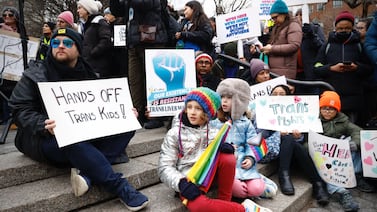Despite the pandemic shutting school buildings last spring and hampering graduation celebrations, Colorado did not see a dip in graduation rates in 2020.
Data published by the Colorado Department of Education on Tuesday showed that the state’s upward trend for graduation rates continued in 2020. Statewide, 81.9% of Colorado’s Class of 2020 graduated on-time in the spring — up from 81.1% in 2019.
Statewide, racial gaps in graduation rates also continued to close slightly as students of color made larger gains than white students last year. The same was true for students from low-income households.
“We know how tough the spring was for our seniors, with many not able to attend their proms or graduation ceremonies due to the COVID-19 pandemic,” said Colorado Education Commissioner Katy Anthes in a released statement. “But we are so proud of the students, their parents, and the teachers who helped them finish the year strong. History will look back at this generation of children and marvel at their perseverance and dedication. A rising graduation rate and a falling dropout rate are wonderful accomplishments, especially during these tough times.”
However, state officials say the pandemic likely will affect graduation rates next year, though to what extent is unknown.
Colorado students were supposed to meet new graduation requirements this year that include showing mastery in English and math through specific tests or advanced classes. But with state tests canceled last spring, some school and district officials worried that students would be behind on meeting those new requirements.
In response, Colorado has allowed districts flexibility in meeting those new requirements for another year.
Even with the delay, many educators are concerned that high school students are at greater risk than before of dropping out or not graduating on time. Many schools, especially high schools, have remained online or in hybrid models with students in school buildings just two or three days a week, and teachers have reported a lack of participation.
Andy Tucker, director of postsecondary workforce readiness for the Colorado Department of Education, said the state has held various meetings with educators to share ideas of how to keep students engaged. The state has also recently updated its dropout prevention framework, with new ideas to keep students involved.
“People have had to pivot,” Tucker said. “Many things have moved to a virtual space. We are hearing about a big push toward virtual internships and career fairs and an increase in industry-sponsored projects.”
In some ways, Tucker said, the move to a virtual environment has helped some schools and districts develop relationships with local businesses that have found it easier to participate in virtual job fairs and to offer some remote work opportunities. Tucker said giving students real-world learning experiences has always been a successful strategy to keep students involved in school.
Still, Tucker said that it’s reasonable to think that graduation rates will be affected long-term, particularly over the next four years as students who experienced a disrupted year of education make their way through high school.
“We always continue to encourage schools and districts to offer students more time even if that means that it takes them more than four years,” Tucker said.
Among the 30 largest districts in the state, 12 had decreases in their four-year rates including Jeffco Public Schools, Douglas County School District, and the Cherry Creek School District. Despite those drops however, most of those same districts saw improvements in rates for students who take five, six, or seven years to graduate.
The Mapleton, Durango, and Adams 14 school districts were among those with the largest improvements to their four-year rates. The improvement is significant for Adams 14, which the state ordered to be run by an outside manager as part of a four-year improvement plan. Without state test results, the district has had little data to show the improvements officials say they’ve made.
Look up your school and district four-year rates in our table below:







